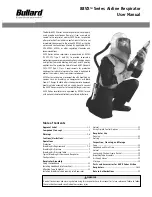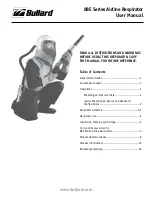
3. Conditions for use
3.1.
Approvals
An EC type examination was carried out for the shotblasting protective helmet C4-PLUS on the basis of EN 14594:2005 ‘Respiratory protective devices –
Compressed air line breathing apparatus with continuous air flow – requirements, testing, identifying marking’.
3.2.
Materials
The materials that are used for this shotblasting protective helmet are carefully selected to provide a product with the minimal weight and maximum safety
provision.
The helmet protects the user in accordance with EN 397, even against falling objects.
None of the materials that are used cause any effect that are hazardous to health or irritate the skin.
3.3.
Warning notes:
Users of respiratory protective devices must be in good health. They must be instructed in the use of respiratory protective devices and familiarized with the
equipment. The occupational health tests in accordance with G 26 ‘Respiratory protection helmets’ must also be taken into consideration.
Suitable, tested and certified hearing protection must be worn during use of the shotblasting protective helmet C4-PLUS.
It is possible for the pressure inside the device to become negative during heavy work that requires greater quantities of air.
The helmet should absorb the energy of an impact through partial destruction or damage to the helmet shell and the inner fittings and each helmet that is
subjected to severe impact should be replaced, even if no damage is recognizable. The users are also made aware of the danger of modifying or removing
the original components of the helmet against the recommendations of the manufactures. The helmets should not be adjusted by the addition of parts in
any way not recommended by the manufacturer. Paint, solvents, adhesives or self-adhesive labels may only be added in accordance with the
manufacturer’s instructions“.
3.3.1.
Special conditions for use
If hazards mean that personal protective equipment is required in addition to respiratory protection then the compatibility of this protective equipment with
the shotblasting protective helmet must be tested very carefully. The additional protective measures may not impede the full efficiency of the shotblasting
protective helmet. The temperature range in which the device can be used is between 0°C to + 45°C. The relevant precautionary measures must be taken
in oxygen-enriched or explosion-prone atmospheres.
The EKASTU Customer Safety Services are happy to provide advice in case of doubt.
4.
Device description
4.1.
Mode of operation
The shotblasting protective helmet C4-PLUS was constructed in such a way that it can also be used for very rough blast-cleaning work. The helmet protects
the wearer from rebounding material. The helmet may not be used for welding or paint-spraying work or in flammable atmospheres. The user must always be
in a position to flee, even without the helmet. The requirements for protection from falling objects are described in EN 397:2000 "Industrial protective
helmets".
4.2.
Identifying marking
The shotblasting protective helmet C4-PLUS is marked on the inside in accordance with EN 14594:2005.
5.
Preparation for use
Check the orderly condition of the entire respiratory protection helmet before use. Check that the warning device is functional (as described below) and
check that all connections are sealed.
Connect the compressed air hose for respiratory protection devices correctly before using the helmet.
The body protection is connected to the edge of the helmet via an integrated, tensioned strap. It is very important to avoid penetration by blast-cleaning material.
The soft collar is connected to the body protection with a zip and can be removed easily for cleaning and disinfection or removed (see 7.3 and 7.4). The soft collar
must be replaced if it is damaged or if it no longer fits closely to the neck. The infinitely adjustable belt must be fixed around the body at waist height and size and
secured.
The compressor must supply breathing air quality in accordance with EN 12021. Compressed air filters from the series D-FL10-PLUS or 20-PLUS
(order no. 122 000 or order no. 122 001, 122 002) may be recommended. The breathing air may not contain less than 19,5% oxygen. The user is responsible for
checking the air supply and its quality. It must also be ensured that the water content in the breathing air is within the limits in EN 12021 in order to avoid the device
freezing. The helmet may not be connected to other supply system such as acetylene, oxygen, nitrogen, argon or oxygen-enriched air etc.
Please check that the compressor is only suctioning clean air, i.e. the compressor must be positioned away from exhaust gas pollution and other poisonous
substances of any kind. It must be ensured that the compressor supplies sufficient breathable air, even if several users are attached to it at the same time.
Set the compressor to 6.0 bar (87 psi) and connect it correctly to the compressed air hose for respiratory protection devices.
The maximum length of the hose is 40 m.
Use only one hose.
Please ensure that 6.0 bar (87 psi), at least 160 l/min to a maximum 300 l/min are supplied for the helmet.
Lay the hose in such a way that it is not at risk of damage. Look out for sharp edges, heat sources, traffic routes etc. Also ensure that the hose route does not
create risk of accident (risk of tripping).
6
Summary of Contents for 144 151
Page 31: ......







































